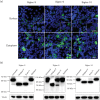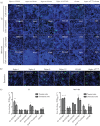Molecular cloning of porcine Siglec-3, Siglec-5 and Siglec-10, and identification of Siglec-10 as an alternative receptor for porcine reproductive and respiratory syndrome virus (PRRSV)
- PMID: 28742001
- PMCID: PMC5656783
- DOI: 10.1099/jgv.0.000859
Molecular cloning of porcine Siglec-3, Siglec-5 and Siglec-10, and identification of Siglec-10 as an alternative receptor for porcine reproductive and respiratory syndrome virus (PRRSV)
Abstract
In recent years, several entry mediators have been characterized for porcine reproductive and respiratory syndrome virus (PRRSV). Porcine sialoadhesin [pSn, also known as sialic acid-binding immunoglobulin-type lectin (Siglec-1)] and porcine CD163 (pCD163) have been identified as the most important host entry mediators that can fully coordinate PRRSV infection into macrophages. However, recent isolates have not only shown a tropism for sialoadhesin-positive cells, but also for sialoadhesin-negative cells. This observation might be partly explained by the existence of additional receptors that can support PRRSV binding and entry. In the search for new receptors, recently identified porcine Siglecs (Siglec-3, Siglec-5 and Siglec-10), members of the same family as sialoadhesin, were cloned and characterized. Only Siglec-10 was able to significantly improve PRRSV infection and production in a CD163-transfected cell line. Compared with sialoadhesin, Siglec-10 performed equally effectively as a receptor for PRRSV type 2 strain MN-184, but it was less capable of supporting infection with PRRSV type 1 strain LV (Lelystad virus). Siglec-10 was demonstrated to be involved in the endocytosis of PRRSV, confirming the important role of Siglec-10 in the entry process of PRRSV. In conclusion, it can be stated that PRRSV may use several Siglecs to enter macrophages, which may explain the strain differences in the pathogenesis.
Figures






Similar articles
-
Porcine, murine and human sialoadhesin (Sn/Siglec-1/CD169): portals for porcine reproductive and respiratory syndrome virus entry into target cells.J Gen Virol. 2013 Sep;94(Pt 9):1955-1960. doi: 10.1099/vir.0.053082-0. Epub 2013 Jun 5. J Gen Virol. 2013. PMID: 23740482
-
Sialoadhesin and CD163 join forces during entry of the porcine reproductive and respiratory syndrome virus.J Gen Virol. 2008 Dec;89(Pt 12):2943-2953. doi: 10.1099/vir.0.2008/005009-0. J Gen Virol. 2008. PMID: 19008379
-
PRRS virus receptors and their role for pathogenesis.Vet Microbiol. 2015 Jun 12;177(3-4):229-41. doi: 10.1016/j.vetmic.2015.04.002. Epub 2015 Apr 13. Vet Microbiol. 2015. PMID: 25912022 Review.
-
Splenic CD163+ macrophages as targets of porcine reproductive and respiratory virus: Role of Siglecs.Vet Microbiol. 2017 Jan;198:72-80. doi: 10.1016/j.vetmic.2016.12.004. Epub 2016 Dec 5. Vet Microbiol. 2017. PMID: 28062010
-
Role of CD163 in PRRSV infection.Virology. 2024 Dec;600:110262. doi: 10.1016/j.virol.2024.110262. Epub 2024 Oct 16. Virology. 2024. PMID: 39423600 Review.
Cited by
-
Porcine Reproductive and Respiratory Syndrome Virus Type 1.3 Lena Triggers Conventional Dendritic Cells 1 Activation and T Helper 1 Immune Response Without Infecting Dendritic Cells.Front Immunol. 2018 Oct 2;9:2299. doi: 10.3389/fimmu.2018.02299. eCollection 2018. Front Immunol. 2018. PMID: 30333837 Free PMC article.
-
Coinfections and their molecular consequences in the porcine respiratory tract.Vet Res. 2020 Jun 16;51(1):80. doi: 10.1186/s13567-020-00807-8. Vet Res. 2020. PMID: 32546263 Free PMC article. Review.
-
Palmitoylation of the envelope membrane proteins GP5 and M of porcine reproductive and respiratory syndrome virus is essential for virus growth.PLoS Pathog. 2021 Apr 23;17(4):e1009554. doi: 10.1371/journal.ppat.1009554. eCollection 2021 Apr. PLoS Pathog. 2021. PMID: 33891658 Free PMC article.
-
Siglecs at the Host-Pathogen Interface.Adv Exp Med Biol. 2020;1204:197-214. doi: 10.1007/978-981-15-1580-4_8. Adv Exp Med Biol. 2020. PMID: 32152948 Free PMC article. Review.
-
Comparison of Primary Virus Isolation in Pulmonary Alveolar Macrophages and Four Different Continuous Cell Lines for Type 1 and Type 2 Porcine Reproductive and Respiratory Syndrome Virus.Vaccines (Basel). 2021 Jun 3;9(6):594. doi: 10.3390/vaccines9060594. Vaccines (Basel). 2021. PMID: 34205087 Free PMC article.
References
MeSH terms
Substances
LinkOut - more resources
Full Text Sources
Other Literature Sources
Research Materials

